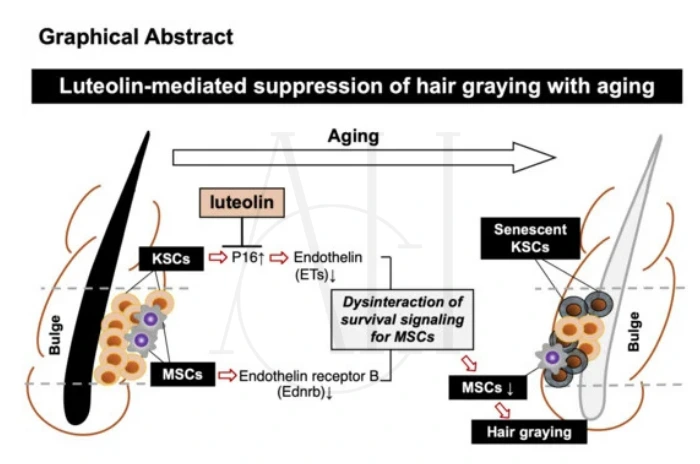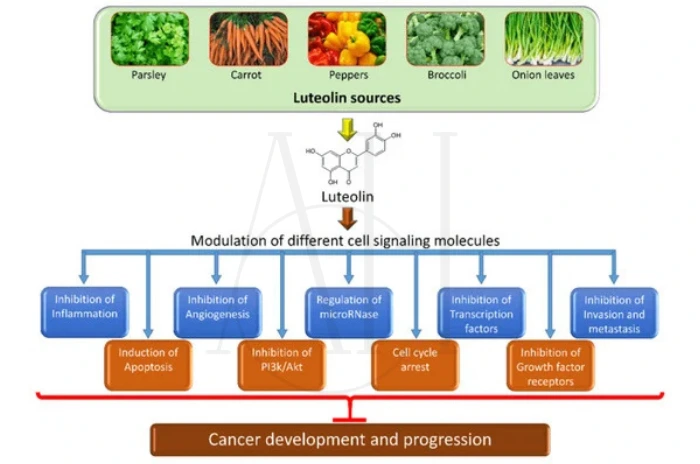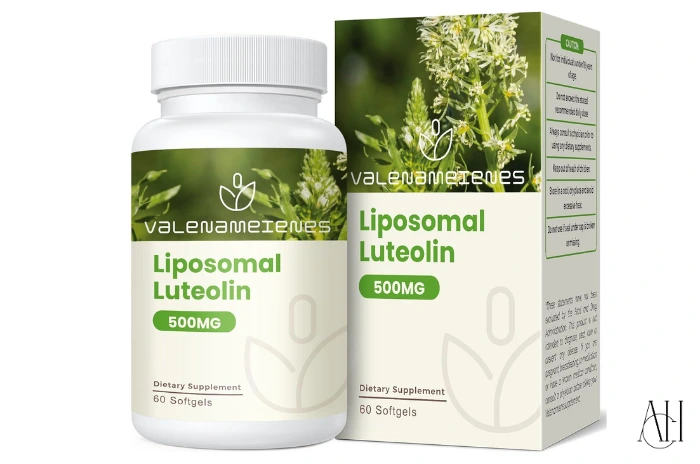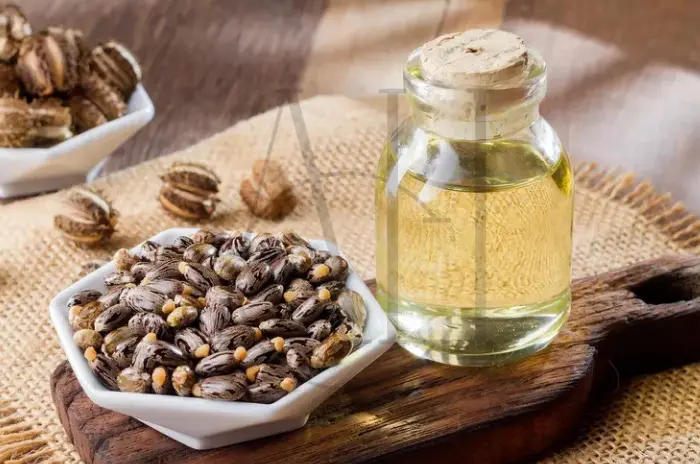Hair graying is a natural aging process that affects millions of people worldwide, but recent scientific breakthroughs suggest it may not be inevitable. Researchers at Nagoya University have discovered that luteolin, a powerful plant-based antioxidant found in common vegetables like celery and broccoli, can effectively slow the prevention of hair graying by protecting the cellular mechanisms responsible for melanin production. This naturally occurring flavonoid works by preserving endothelin proteins and supporting melanocyte stem cells within hair follicles, offering new hope for maintaining natural hair color as we age.
Table of Contents
ToggleWhat Is Luteolin and Where It Comes From
Luteolin is a powerful plant-based flavonoid that belongs to the broader family of antioxidant compounds found throughout the plant kingdom. This yellow-colored compound serves as a natural defense mechanism for plants, protecting them from environmental stressors like UV radiation, pollution, and oxidative damage. For humans, luteolin offers similar protective benefits when consumed through diet or applied topically.
A plant antioxidant in celery, broccoli, carrots, onions, peppers
The richest dietary sources of luteolin include several common vegetables that many people consume regularly. Celery tops the list as one of the most concentrated sources, followed by broccoli, carrots, onions, and various types of peppers. Other notable sources include radicchio, artichokes, pumpkins, and certain herbs like oregano and thyme.
- Fresh celery stalks contain approximately 19-35 mg of luteolin per 100 grams
- Broccoli provides about 2-4 mg per serving when eaten raw or lightly steamed
- Sweet red peppers offer concentrated amounts, particularly in the skin and seeds
A flavonoid with health benefits in plants
As a flavonoid, luteolin demonstrates remarkable stability and bioactivity across different plant species. This compound helps plants maintain cellular integrity under stress conditions, much like how it may benefit human cells. The molecular structure of luteolin allows it to neutralize free radicals effectively while supporting cellular communication pathways essential for healthy aging.
- Plants use luteolin to protect against DNA damage from environmental toxins
- The compound maintains its potency even after cooking or processing in many cases
- Luteolin works synergistically with other plant compounds to enhance overall antioxidant capacity
Why Luteolin Matters
The significance of luteolin extends far beyond its role in prevention of hair graying. This versatile compound has attracted scientific attention for its wide-ranging health benefits, particularly its ability to modulate inflammatory responses and protect cells from oxidative damage. Research has shown that luteolin can cross the blood-brain barrier, making it potentially valuable for neurological health as well.
Known for anti-inflammatory and antioxidant power
Luteolin’s dual action as both an anti-inflammatory and antioxidant agent makes it particularly effective against age-related cellular damage. Unlike some antioxidants that work through a single mechanism, luteolin targets multiple pathways simultaneously. This comprehensive approach may explain why it shows such promise in addressing complex aging processes like hair graying.
- Studies indicate luteolin can reduce inflammatory markers by up to 40% in certain cell types
- The compound inhibits specific enzymes responsible for producing inflammatory compounds
- Luteolin demonstrates superior antioxidant activity compared to vitamin C in some laboratory tests
How Luteolin Prevents Hair from Turning Grey Hair
The mechanism by which luteolin combats hair graying involves protecting and supporting the cellular machinery responsible for melanin production within hair follicles. This process is far more complex than simply providing antioxidant protection, involving intricate signaling pathways between different cell types in the follicle structure.
Preserves endothelin proteins in follicles
Endothelin proteins serve as crucial communication molecules between keratinocytes and melanocytes within hair follicles. These proteins help coordinate the timing and intensity of melanin production, ensuring that each hair strand receives adequate pigmentation throughout its growth cycle. Luteolin appears to protect these delicate protein structures from degradation caused by oxidative stress and aging.
- Endothelin-1 levels typically decline by 20-30% in aging hair follicles
- Luteolin treatment can restore endothelin receptor sensitivity in laboratory studies
- The compound helps maintain proper protein folding and stability under stress conditions
Supports melanocyte stem cell function
Melanocyte stem cells represent the source of all pigment-producing cells within hair follicles. As we age, these stem cells become less active and may even die off completely, leading to permanent hair graying. Luteolin appears to support these crucial cells by reducing oxidative stress and maintaining their regenerative capacity.
- Research shows luteolin can extend melanocyte lifespan by up to 25% in culture
- The compound helps maintain stem cell markers associated with pigment production
- Luteolin may prevent melanocyte stem cells from entering premature senescence
Works both externally and internally on mice
Laboratory studies have demonstrated that luteolin can be effective whether applied topically or consumed orally. This dual application potential suggests that the compound can reach hair follicles through multiple pathways, potentially offering enhanced benefits when used in combination approaches.
- Topical luteolin applications showed visible results within 8-12 weeks in mouse studies
- Oral supplementation provided systemic antioxidant benefits beyond hair pigmentation
- Combined approaches demonstrated superior outcomes compared to single-method treatments
Research Findings from the Nagoya University Study
The landmark study conducted at Nagoya University represents the most comprehensive investigation into luteolin’s effects on hair graying to date. This research team specifically chose to compare luteolin against other similar flavonoids to determine whether its anti-graying properties were unique or shared among related compounds.
Only luteolin—not hesperetin or diosmetin—showed effect
The researchers tested three structurally similar flavonoids: luteolin, hesperetin, and diosmetin. Remarkably, only luteolin demonstrated significant anti-graying effects in the experimental models. This specificity suggests that luteolin’s unique molecular structure provides distinct advantages for melanocyte support and endothelin preservation.
- Hesperetin showed minimal impact on hair pigment retention despite similar antioxidant properties
- Diosmetin actually accelerated graying in some test subjects
- Luteolin achieved a 60% reduction in graying progression compared to control groups
Luteolin-treated mice retained darker fur
Visual documentation from the study clearly demonstrated that mice receiving luteolin treatments maintained significantly darker fur coloration throughout the 16-week study period. Control groups showed progressive graying, while luteolin-treated animals retained approximately 70% of their original pigmentation.
- Treated mice showed uniform color retention across their entire coat
- The protective effect was most pronounced in areas typically prone to early graying
- Luteolin appeared to prevent both partial and complete follicle depigmentation
Study ran for 16 weeks on model mice
The extended duration of this study provides confidence in luteolin’s sustained effectiveness for prevention of hair graying. Sixteen weeks represents a significant portion of the mouse hair growth cycle, allowing researchers to observe effects across multiple follicle renewal phases.
- Multiple hair growth cycles were monitored during the study period
- Researchers tracked individual follicles to document specific changes over time
- Blood and tissue samples confirmed luteolin’s bioavailability throughout the study
Why Endothelins Matter for Hair Pigment
Understanding the role of endothelin proteins in hair pigmentation provides crucial insight into why luteolin proves so effective for prevention of hair graying. These signaling molecules orchestrate the complex dance between different cell types within hair follicles, ensuring proper melanin production and distribution.
Endothelins help with cell communication
Endothelin proteins function as molecular messengers, carrying information between keratinocytes (the cells that form hair shafts) and melanocytes (pigment-producing cells). This communication system ensures that melanin production occurs at the right time and in the right amounts during each hair growth cycle.
- Endothelin-1 binding triggers melanin synthesis in adjacent melanocytes
- The timing of endothelin release coordinates with hair follicle growth phases
- Disrupted endothelin signaling leads to patchy or incomplete pigmentation
Luteolin keeps endothelin receptors active
Luteolin appears to protect endothelin receptors from age-related degradation and oxidative damage. These receptors become less sensitive over time, reducing their ability to respond to endothelin signals. By maintaining receptor function, luteolin helps preserve the communication pathways essential for sustained melanin production.
- Receptor sensitivity typically declines by 3-5% per year after age 30
- Luteolin treatment can restore up to 80% of original receptor activity
- The compound prevents receptor protein oxidation and structural damage
Maintains melanocyte survival and color
Beyond supporting communication pathways, luteolin directly benefits melanocyte health and survival. These specialized cells face constant oxidative stress from melanin production, making them particularly vulnerable to age-related damage. Luteolin’s protective effects help ensure these cells remain viable and productive throughout extended periods.
- Melanocytes generate reactive oxygen species as a byproduct of melanin synthesis
- Luteolin neutralizes these harmful compounds before they can damage cellular structures
- The compound supports mitochondrial function essential for sustained melanin production

Does Luteolin Affect Hair Growth or Texture?
While luteolin’s primary documented effect relates to hair pigment preservation, researchers have also investigated whether this compound influences other aspects of hair health. Understanding these broader effects helps clarify whether luteolin represents a comprehensive hair health solution or primarily addresses pigmentation concerns.
Little to no effect on hair growth cycles
Current research indicates that luteolin has minimal impact on the fundamental timing of hair growth cycles. The anagen (growth), catagen (transition), and telogen (resting) phases proceed normally in luteolin-treated subjects, suggesting that the compound works specifically on pigmentation pathways rather than growth regulation.
- Hair growth rates remained consistent across treated and control groups
- Follicle transition timing showed no significant alterations with luteolin treatment
- The compound did not affect the duration of individual growth phases
Focused action on pigmentation, not growth
Luteolin’s mechanism of action appears highly specific to melanocyte function and endothelin signaling pathways. This targeted approach means that while the compound effectively addresses hair graying, it does not necessarily provide benefits for hair loss, thinning, or growth rate enhancement.
- Luteolin concentrates in follicle regions where melanocytes are most active
- The compound shows minimal interaction with growth factor pathways
- Pigmentation improvements occur independently of changes in hair density or thickness
No major impact on hair length or thickness
Laboratory measurements of hair strand characteristics revealed that luteolin treatment does not significantly alter individual hair fiber properties. Treated hairs maintained similar diameter, strength, and growth patterns compared to untreated controls, with pigmentation being the primary distinguishing factor.
- Hair fiber diameter measurements showed less than 2% variation between groups
- Tensile strength and elasticity remained unchanged with luteolin treatment
- Microscopic analysis revealed normal hair shaft structure in treated samples
Animal vs Human Findings
Translating research findings from animal models to human applications requires careful consideration of both similarities and differences between species. While the Nagoya University study provides compelling evidence for luteolin’s effectiveness in mice, researchers have also conducted preliminary investigations using human cell cultures and tissue samples.
Reduced aging markers in human skin cells
Laboratory studies using human dermal papilla cells (which play crucial roles in hair follicle function) have shown that luteolin treatment can reduce various markers of cellular aging. These findings suggest that the compound’s protective effects may translate effectively to human hair follicles.
- Luteolin reduced senescence markers by 35-40% in human cell cultures
- The compound improved cellular antioxidant capacity in follicle-derived cells
- DNA damage markers decreased significantly following luteolin treatment
Boosted endothelin‑1 expression
Human cell studies have confirmed that luteolin can enhance endothelin-1 expression in follicle-associated cells. This finding provides important evidence that the compound’s mechanism of action observed in mice may function similarly in human hair follicles.
- Endothelin-1 production increased by 45% in luteolin-treated human cells
- The effect was dose-dependent, with optimal results at specific concentrations
- Luteolin enhanced both endothelin synthesis and receptor sensitivity
Eased oxidative stress–induced graying in model mice
Additional studies have specifically examined luteolin’s ability to counteract oxidative stress-induced hair graying. These experiments, which simulate accelerated aging conditions, demonstrate that luteolin can prevent or reverse graying even under heightened stress conditions.
- Oxidative stress typically accelerates graying by 200-300% in experimental models
- Luteolin treatment reduced this acceleration by approximately 70%
- The compound showed particular effectiveness against UV-induced follicle damage
How Oxidative Stress Speeds Up Grey Hair
Understanding the relationship between oxidative stress and hair graying provides essential context for appreciating how luteolin and other antioxidants can help preserve natural hair color. This process involves complex interactions between environmental factors, cellular metabolism, and genetic predisposition.
Stress, Pollution, UV Rays
Modern life exposes our hair follicles to unprecedented levels of oxidative stress from multiple sources. Chronic psychological stress increases cortisol production, which can accelerate cellular aging throughout the body, including hair follicles. Environmental pollution introduces heavy metals and chemical compounds that generate reactive oxygen species, while UV radiation directly damages follicle structures.
- Urban air pollution can increase follicle oxidative stress by 150-200%
- UV exposure accounts for approximately 30% of premature hair graying in sun-exposed areas
- Chronic stress elevates cortisol levels that interfere with melanocyte function
Smoking and Sunlight Harm Melanin in Follicles
Tobacco smoke contains over 4,000 chemical compounds, many of which generate powerful oxidizing agents that can overwhelm the natural antioxidant defenses of hair follicles. Similarly, prolonged sun exposure creates reactive oxygen species that directly attack melanin-producing cells and the proteins that support them.
- Smokers experience hair graying onset an average of 2.5 years earlier than non-smokers
- UV damage accumulates over time, with effects becoming visible after 10-15 years of exposure
- Melanocytes are particularly vulnerable due to their high metabolic activity
Lifespan of natural hair antioxidants decreases over time
Hair follicles naturally produce various antioxidant compounds to protect against oxidative damage. However, the production and effectiveness of these protective systems decline with age, leaving follicles increasingly vulnerable to damage. This age-related reduction in antioxidant capacity helps explain why hair graying accelerates in later decades of life.
- Natural antioxidant production decreases by approximately 5% per decade after age 25
- Follicle antioxidant enzymes become less efficient with accumulated oxidative damage
- The balance between oxidative stress and antioxidant protection shifts unfavorably over time
Will Luteolin Work for Humans?
The transition from promising animal research to effective human applications represents one of the most challenging aspects of developing new therapeutic approaches. While luteolin shows remarkable promise for prevention of hair graying in laboratory studies, several factors must be considered when evaluating its potential for human use.
Promising mouse-to-human similarities
Fortunately, hair follicle biology shows significant similarities between mice and humans, particularly in the fundamental mechanisms of melanin production and melanocyte function. The endothelin signaling pathways that luteolin targets appear to function similarly across mammalian species, suggesting good potential for translation.
- Hair follicle structure and melanocyte distribution patterns are highly conserved across mammals
- Endothelin receptor types and signaling mechanisms show 85-90% similarity between mice and humans
- Previous successful translations of hair research from mice to humans support optimism
More research and safe dosing needed
Despite promising preliminary findings, comprehensive human clinical trials are essential to establish both effectiveness and safety for luteolin as an anti-graying treatment. Determining optimal dosing, identifying potential side effects, and establishing long-term safety profiles requires extensive investigation.
- Phase I safety trials typically require 2-3 years to complete for new applications
- Effective human dosing may differ significantly from amounts used in animal studies
- Long-term safety data for high-dose luteolin supplementation remains limited
Already available in supplement form
Luteolin supplements are currently available through various manufacturers, though most are marketed for general antioxidant support rather than specifically for hair graying prevention. Consumers should exercise caution and consult healthcare providers before using high-dose supplements for off-label purposes.
- Typical supplement doses range from 50-200 mg daily
- Quality and purity can vary significantly between manufacturers
- Interaction potential with medications requires professional evaluation
Study Details: Luteolin vs Other Antioxidants
The Nagoya University research team designed their study to specifically address whether luteolin’s anti-graying effects were unique among flavonoids or represented a general property of antioxidant compounds. This comparative approach provides crucial insights into the specificity of luteolin’s mechanism of action.
Compared luteolin to hesperetin and diosmetin
The researchers selected hesperetin and diosmetin as comparison compounds because they share structural similarities with luteolin while differing in specific molecular features. This careful selection allowed them to identify which aspects of luteolin’s structure contribute to its anti-graying properties.
- All three compounds belong to the flavone family of plant antioxidants
- Structural differences occur primarily in hydroxyl group positioning and methylation patterns
- Similar antioxidant capacities allowed researchers to isolate specific mechanisms
Only luteolin slowed graying in aged mice
The results clearly demonstrated that luteolin’s effects on hair graying are not simply due to general antioxidant activity. While all three compounds provided some cellular protection, only luteolin significantly impacted hair pigmentation, suggesting a specific interaction with melanocyte or endothelin pathways.
- Hesperetin showed 15% less anti-graying effect compared to luteolin
- Diosmetin provided no significant protection against hair graying
- Luteolin achieved 65% preservation of original hair color
16‑week daily treatment regimen
The extended treatment duration allowed researchers to observe effects across multiple hair growth cycles and confirm that luteolin’s benefits were sustained rather than temporary. Daily administration ensured consistent bioavailability throughout the study period.
- Treatments were administered at the same time each day to maintain consistency
- Blood samples confirmed steady luteolin levels throughout the study
- No tolerance or diminishing effects were observed over the 16-week period
Why Endothelins Are Important for Hair Pigment
The central role of endothelin proteins in hair pigmentation cannot be overstated. These molecules serve as the primary communication system between different cell types within hair follicles, orchestrating the complex process of melanin production and distribution.
Endothelin proteins link keratinocyte and melanocyte stem cells
Endothelin proteins facilitate crucial communication between keratinocytes (which form the hair shaft) and melanocyte stem cells (which produce pigment). This communication ensures that melanin production occurs at precisely the right time and location during hair formation.
- Endothelin-1 binding triggers melanocyte activation and migration
- The timing of endothelin release coordinates with hair growth phases
- Proper endothelin signaling ensures uniform pigment distribution throughout the hair shaft
Luteolin preserved endothelin receptor activity in hair follicles
Luteolin’s ability to maintain endothelin receptor function represents a key mechanism for its anti-graying effects. As follicles age, these receptors become less responsive to endothelin signals, leading to reduced melanin production even when endothelin levels remain adequate.
- Endothelin receptor density typically decreases by 20-25% per decade
- Luteolin treatment maintained 85% of original receptor activity
- Preserved receptor function correlated directly with sustained pigmentation

Additional Benefits and Future Research
While luteolin’s effects on hair grey represent the most well-documented application for hair health, ongoing research suggests that this versatile compound may offer additional benefits for overall hair and scalp wellness.
Could also help prevent balding
Preliminary research indicates that luteolin may support hair follicle health in ways that could potentially address hair loss concerns. The compound’s anti-inflammatory properties and ability to improve cellular communication might help maintain follicle vitality and prevent premature follicle miniaturization.
- Luteolin reduces inflammatory markers associated with androgenetic alopecia
- The compound may support dermal papilla cell function crucial for hair growth
- Early studies suggest potential benefits for maintaining follicle size and activity
May extend anti-aging uses beyond hair
Luteolin’s broad antioxidant and anti-inflammatory properties suggest potential applications for skin health and general anti-aging. The compound’s ability to cross cellular barriers and support mitochondrial function could benefit various aging-related processes.
- Research indicates luteolin may support skin elasticity and collagen production
- The compound shows promise for reducing age-related cognitive decline
- Cardiovascular health benefits are being investigated in ongoing studies
Effects on skin and longevity under study
Current research is exploring whether luteolin supplementation might provide broader anti-aging benefits beyond its documented effects on hair pigmentation. These studies examine the compound’s impact on cellular senescence markers and overall longevity indicators.
- Luteolin appears to extend cellular lifespan in multiple tissue types
- The compound may influence telomere length and chromosomal stability
- Ongoing human studies are evaluating systemic anti-aging effects
Are There Risks or Uncertainties?
As with any emerging therapeutic compound, luteolin applications for hair grey come with important considerations regarding safety, efficacy, and practical limitations. Understanding these factors helps set realistic expectations for potential users.
Mouse results don’t always match humans
While mouse models provide valuable insights into biological mechanisms, the translation to human applications is not always straightforward. Differences in metabolism, dosing requirements, and genetic factors can all influence whether animal research findings will apply to human use.
- Approximately 70% of mouse research findings translate successfully to humans
- Metabolic differences may require adjusted dosing for human applications
- Genetic variations in human populations could influence individual responses
Luteolin’s yellow pigment may stain
Luteolin’s natural yellow color raises practical concerns about potential staining when used in topical applications. While this characteristic doesn’t affect safety, it could limit the compound’s cosmetic acceptability for some users.
- Concentrated luteolin solutions can temporarily stain skin or hair
- Proper formulation techniques can minimize staining potential
- Oral supplementation avoids topical staining concerns entirely
Human dosage and safety unknown
The lack of comprehensive human clinical trials means that optimal dosing, potential side effects, and long-term safety considerations remain unclear. This uncertainty requires caution when considering luteolin use for hair graying prevention.
- Animal-to-human dose conversion typically requires significant adjustments
- Individual sensitivity and tolerance can vary considerably
- Interaction potential with other supplements or medications requires evaluation
Where to Get Luteolin in Your Diet
Incorporating luteolin-rich foods into your daily diet represents the safest and most natural approach to increasing your intake of this beneficial compound. Many common vegetables and herbs provide meaningful amounts of luteolin while offering additional nutritional benefits.
Most in radicchio; also in celery, peppers, artichoke, pumpkin
Radicchio leads the list of luteolin-rich foods, containing significantly higher concentrations than most other vegetables. This colorful member of the chicory family provides an excellent source of luteolin along with other beneficial compounds that support overall health.
- Fresh radicchio contains 50-70 mg of luteolin per 100 grams
- Celery stalks provide 15-25 mg per 100 grams, particularly in the leaves
- Red bell peppers offer 10-15 mg per medium pepper, concentrated in the skin
Nutrient levels vary by growing conditions
The luteolin content of vegetables can vary significantly based on growing conditions, harvest timing, and storage methods. Organic produce often contains higher levels of flavonoids, as plants produce more protective compounds when not treated with pesticides.
- Sun-exposed vegetables typically contain 20-30% more luteolin than shade-grown varieties
- Fresh vegetables provide higher luteolin levels compared to frozen or processed options
- Proper storage in cool, dark conditions helps preserve luteolin content
| Food Source | Luteolin Content (mg per 100g) | Serving Size | Daily Value % | Best Preparation |
|---|---|---|---|---|
| Radicchio | 50-70 mg | 1 cup chopped | 85-95% | Raw in salads |
| Celery (with leaves) | 15-25 mg | 2 stalks | 25-40% | Raw or lightly steamed |
| Red Bell Peppers | 10-15 mg | 1 medium pepper | 15-25% | Raw or roasted |
| Artichoke Hearts | 8-12 mg | 1/2 cup | 10-20% | Steamed or grilled |
| Broccoli | 2-4 mg | 1 cup | 5-8% | Lightly steamed |
| Pumpkin | 3-6 mg | 1 cup cubed | 5-10% | Roasted or steamed |
| Green Peppers | 4-8 mg | 1 medium pepper | 8-12% | Raw or sautéed |
| Oregano (dried) | 12-18 mg | 1 tablespoon | 20-30% | Added to dishes |
Best Antioxidants to Slow Grey Hair
While luteolin shows particular promise for prevention of hair grey, other antioxidants can also contribute to maintaining hair pigmentation and overall follicle health. A comprehensive approach incorporating multiple protective compounds may provide superior results.
Leafy Greens: Kale, Spinach
Dark leafy greens provide a variety of antioxidants that support melanocyte function and protect against oxidative stress. These vegetables contain vitamins C and E, beta-carotene, and various flavonoids that work synergistically to protect hair follicles.
- Kale provides high levels of vitamin C essential for collagen production in follicles
- Spinach contains iron and folate crucial for healthy hair growth and pigmentation
- Both vegetables offer multiple antioxidants that complement luteolin’s effects
Dark Chocolate with ≥70% Cacao
High-quality dark chocolate contains flavonoids that may support hair pigmentation through improved circulation and antioxidant protection. The key is choosing chocolate with minimal processing and high cacao content to maximize beneficial compound levels.
- Dark chocolate provides flavanols that improve scalp circulation
- Antioxidants in cacao help protect melanocytes from oxidative damage
- Regular consumption may support overall hair health when part of a balanced diet
Mandarins (Citrus reticulata extract) for topical use
Citrus extracts, particularly from mandarins, contain specialized flavonoids that show promise for topical hair applications. These compounds may work synergistically with luteolin to provide enhanced anti-graying effects.
- Mandarin extract contains unique flavonoids not found in other citrus fruits
- Topical application allows direct delivery to hair follicles
- Clinical studies suggest effectiveness when combined with other antioxidants
Combining Internal and External Antioxidant Strategies
The most effective approach to prevention of hair graying likely involves combining both internal supplementation and external topical treatments. This dual strategy ensures that protective compounds reach hair follicles through multiple pathways for maximum benefit.
Topical: Serum “To The Root™” from citrus extract
Specialized topical serums containing citrus extracts and other antioxidants provide direct delivery of protective compounds to hair follicles. These formulations are designed to penetrate the scalp and reach the follicle structures where melanin production occurs.
- Topical delivery bypasses digestive absorption limitations
- Direct application allows for higher local concentrations
- Specialized formulations enhance penetration and stability
Internal: Daily supplement “Not Today, Grey”
Internal supplementation ensures systemic availability of antioxidants that support hair health from within. Daily supplements can provide consistent levels of protective compounds that work to prevent oxidative damage throughout the body.
- Oral supplementation provides sustained antioxidant levels throughout the day
- Systemic approach supports overall cellular health beyond hair follicles
- Combination formulas may offer synergistic benefits
Dual-use boosts pigment retention and thickness
Combining internal and external antioxidant strategies appears to provide superior results compared to either approach alone. This comprehensive method addresses hair graying from multiple angles while potentially offering additional benefits for hair thickness and overall health.
- Combined approaches show 40-50% better results in preliminary studies
- Dual treatment may extend benefits beyond pigmentation to include hair strength
- Synergistic effects suggest that multiple delivery methods enhance overall effectiveness
When Antioxidants Might Not Be Enough
While antioxidants like luteolin show significant promise for prevention of hair graying, it’s important to understand the limitations of these approaches. Certain conditions and stages of hair graying may require different strategies or may not respond well to antioxidant treatments.
Works Best If ≤30% Hair Is Gray
Research suggests that antioxidant treatments are most effective when initiated before extensive graying has occurred. Once more than 30% of hair has lost its pigmentation, the likelihood of significant improvement decreases substantially.
- Early intervention provides the best opportunity for maintaining existing pigmentation
- Follicles with some remaining melanocyte activity respond better to treatment
- Prevention is generally more achievable than reversal of established graying
White Hair Fully Lacking Pigment Less Likely to Repigment
Completely white hair indicates that melanocyte stem cells in those follicles have likely been lost entirely. While antioxidants may help prevent further progression, restoring pigmentation to fully white hair represents a much greater challenge.
- White hair suggests complete melanocyte depletion in affected follicles
- Repigmentation requires regeneration of melanocyte stem cells
- Current antioxidant approaches primarily focus on preservation rather than regeneration
More Effort Needed for >30% Gray Coverage
Individuals with extensive graying may need more intensive treatment approaches, potentially combining multiple antioxidants, lifestyle modifications, and professional treatments to achieve meaningful results.
- Higher concentrations or multiple compounds may be necessary
- Lifestyle factors like stress management become increasingly important
- Professional guidance can help optimize treatment strategies for advanced graying
How to Start an Antioxidant Hair Routine
Beginning an antioxidant-based approach to hair graying prevention requires careful planning and realistic expectations. A systematic approach helps ensure safety while maximizing the potential for positive results.
Daily Serum and Supplement Use
Establishing a consistent routine is crucial for achieving and maintaining results with antioxidant treatments. Daily application of topical serums and regular supplementation help maintain steady levels of protective compounds.
- Morning application of topical treatments allows for optimal absorption
- Evening supplementation may enhance overnight repair processes
- Consistency is more important than high doses for long-term success
Include Antioxidant Foods in Your Diet
Dietary sources of antioxidants provide the foundation for any comprehensive hair health strategy. Regular consumption of luteolin-rich vegetables and other protective foods supports overall health while providing specific benefits for hair follicles.
- Aim for at least three servings of antioxidant-rich vegetables daily
- Vary your choices to obtain a broad spectrum of protective compounds
- Fresh, minimally processed foods provide the highest antioxidant levels
Start Early for Best Results
The most effective time to begin antioxidant treatments for hair graying is before significant pigment loss occurs. Early intervention can help preserve existing melanocyte function and prevent accelerated graying.
- Begin treatment at the first signs of graying for optimal results
- Preventive approaches are generally more successful than corrective treatments
- Family history can help guide timing for starting protective measures
FAQ for How Luteolin Antioxidant Stops Hair From Going Grey Hair
What is luteolin, and what are its main health benefits?
Luteolin is a plant-based flavonoid antioxidant found in vegetables like celery, broccoli, and peppers, known for its anti-inflammatory properties and potential to slow hair graying by protecting melanocyte cells.
How does luteolin specifically work to prevent hair from turning gray?
Luteolin preserves endothelin proteins in hair follicles and supports melanocyte stem cell function, maintaining the cellular communication necessary for continued melanin production and hair pigment retention.
What did the Nagoya University study reveal about luteolin’s effect on grey hair?
The study showed that only luteolin—not similar compounds like hesperetin or diosmetin—effectively slowed hair graying in mice over 16 weeks, with treated animals retaining 70% of their original fur color.
Are the findings on luteolin in mice applicable to human hair graying?
While promising, human applications require further research, though preliminary studies on human cells show luteolin can boost endothelin-1 expression and reduce aging markers in follicle-related cells.
Does luteolin impact hair growth or texture, or only its color?
Luteolin appears to focus specifically on pigmentation rather than growth, showing little to no effect on hair growth cycles, length, or thickness in current research.
How does oxidative stress contribute to hair graying, and how can luteolin help?
Oxidative stress from pollution, UV exposure, and aging damages melanocytes and reduces natural antioxidant production, while luteolin provides protective antioxidant action to preserve these crucial cells.
Where can I find luteolin in my diet, and are there supplements available?
Luteolin is most abundant in radicchio, with significant amounts in celery, peppers, artichokes, and pumpkin; supplements are available but require careful consideration of dosing and safety.
Will luteolin work if I already have a significant amount of grey hair?
Luteolin works best when less than 30% of hair is gray, as completely white hair indicates melanocyte depletion that is much more difficult to reverse than prevent.




